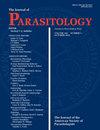四种同属龟类棘尾虫的生命周期变异和寄主与寄生虫之间的相互作用。
摘要
新棘皮动物属中的龟类棘皮动物具有复杂的生命周期,被认为涉及一个梭形纲中间宿主和一个龟类最终宿主。对 Neoechinorhynchus emydis 而言,额外的蜗牛副宿主是其生命周期的一部分。然而,蜗牛是如何被感染的,以及蜗牛中是否还能发现其他种类的 Neoechinorhynchus,目前仍不清楚。本研究旨在了解 4 种龟类棘头蜱(Neoechinorhynchus chrysemydis、N. emydis、Neoechinorhynchus emyditoides 和 Neoechinorhynchus pseudemydis)在中间宿主、副宿主和最终宿主中的生存、发育和宿主利用情况。利用从俄克拉荷马州自然感染的乌龟宿主的成体棘头蚴中回收的卵,对 2 种鸵鸟和 1 种淡水螺进行了实验性感染。为了更好地了解资源竞争情况,还生成了这些棘头螯虾及其海龟最终宿主的离子组。鸵鸟摄食后,所有 4 种棘皮动物的卵都在两种鸵鸟体内孵化。然而,在Cypridopsis sp.梭形目中,棘头螯虾没有进一步发育,而在Physocypria sp.梭形目中,所有4种棘头螯虾都在28-32天内生长发育为可感染的幼体。在这 4 种棘头蚴中,N. emydis 早期在梭形目动物体内生长较快,是唯一能在蜗牛宿主体内存活和建立的物种。通过观察摄入感染了 N. chrysemydis、N. emyditoides 和 N. pseudemydis 的梭子蟹的蜗牛粪便中的长鼻残留物,这一发现得到了佐证。与此相反,当蜗牛接触到所有 4 种棘头虫的虫卵时,虫卵会随粪便排出,不会造成感染。成体棘头蚴及其海龟宿主的总体离子组成表明,宿主和寄生虫共享宿主资源。不过,特定元素的差异表明,乌龟棘头蚤体内积累的重金属浓度高于宿主体内的重金属浓度。本研究结果支持之前的实地观察和假设:(1)Physocypria sp.emyditoides和N. pseudemydis的传播途径;(3) 成虫时,这4种棘头蚴在离子组成方面利用龟的最终宿主的情况相似。这项工作挑战了棘头螯虾生命周期的传统观点,为未来的假说奠定了基础。Turtle acanthocephalans in the genus Neoechinorhynchus have complex life cycles and are thought to involve an ostracod intermediate host and a turtle definitive host. For Neoechinorhynchus emydis, an additional snail paratenic host is part of its life cycle. However, how snails become infected and whether other species of Neoechinorhynchus can be found in snails remains unclear. This study was conducted to understand the survival, development, and host use of 4 species of turtle acanthocephalans (Neoechinorhynchus chrysemydis, N. emydis, Neoechinorhynchus emyditoides, and Neoechinorhynchus pseudemydis) in their intermediate, paratenic, and definitive hosts. Using eggs recovered from adult acanthocephalans from naturally infected turtle hosts in Oklahoma, experimental infections were conducted in 2 species of ostracods and 1 species of freshwater snail. Ionomes also were generated for these acanthocephalans and their turtle definitive hosts to better understand resource competition. Upon ingestion by ostracods, eggs of all 4 species of acanthocephalans hatched in both ostracod species. However, no further acanthocephalan development occurred in Cypridopsis sp. ostracods, whereas all 4 acanthocephalan species grew and developed into infective juveniles over 28-32 days in Physocypria sp. ostracods. Of the 4 species of acanthocephalans, N. emydis grew faster early in ostracods and was the only species to survive and establish in snail hosts. This finding was supported by the observation of proboscis remnants in the feces of snails that ingested ostracods infected with N. chrysemydis, N. emyditoides, and N. pseudemydis. In contrast, when snails were exposed to eggs of all 4 acanthocephalan species, eggs were passed in the feces, resulting in no infections. The overall ionomic composition of adult acanthocephalans and their turtle hosts suggested that the hosts and parasites share host resources. However, specific elemental differences indicated that turtle acanthocephalans can accumulate heavy metals at concentrations higher than those in their hosts. Results of this study support previous field observations and hypotheses that (1) Physocypria sp. ostracods serve as intermediate hosts for N. chrysemydis, N. emydis, N. emyditoides, and N. pseudemydis; (2) N. emydis uses snail paratenic hosts, but snails are a non-viable route of transmission to turtles for N. chrysemydis, N. emyditoides, and N. pseudemydis; and (3) as adults, these 4 acanthocephalan species utilize their turtle definitive hosts similarly in terms of ionomic composition. This work challenges the traditional view of the acanthocephalan life cycle and sets the stage for future hypotheses.

 求助内容:
求助内容: 应助结果提醒方式:
应助结果提醒方式:


